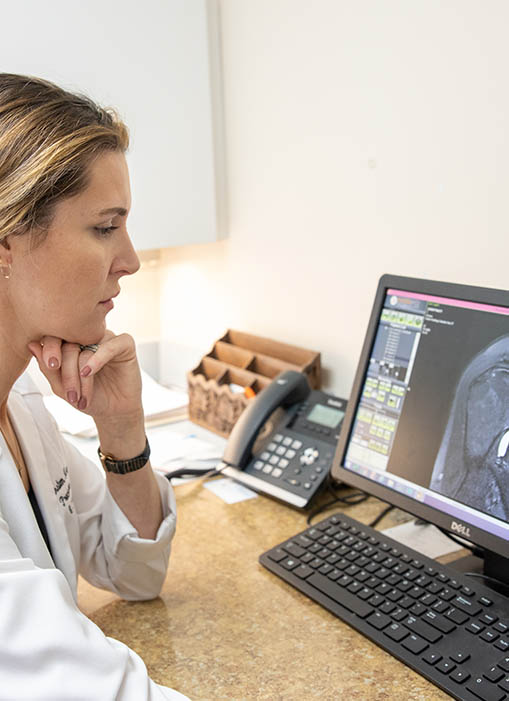Rotator Cuff Tear
Learn more about our capabilities to treat rotator cuff pain.
Quick Facts on Rotator Cuff Tears
- Rotator cuff tears can be painful and cause the limited function of the shoulder.
- Our Sports Medicine doctors and orthopedic surgeons specializing in shoulder arthroscopy can recognize the pattern of the torn rotator cuff and help to mobilize torn muscle.
- Rotator cuff pain and injuries can be treated in a non-operative manner or via arthroscopic rotator cuff repair, depending on the severity of the injury and how early treatment can be delivered.
- Shoulder rehabilitation with our physical therapy teams is critical for a successful outcome after an arthroscopic rotator cuff repair.
What is a rotator cuff tear?
Rotator cuff pain and disorders range from tendonitis to partial tears to full-thickness tears when the muscle is completely detached from the bone. The rotator cuff is a group of four muscles that surrounds the shoulder that functions to provide the strength and support to perform overhead activities. This group of muscles is precariously situated between the shoulder blade and collarbone above and the shoulder joint below.
Some people have a spur on the underside of the shoulder blade and collarbone which pinches the rotator cuff and can cause inflammation or tearing of the rotator cuff. This is frequently known as impingement and can be seen with tendonitis, partial tears, or full-thickness rotator cuff tears.

How do rotator cuff pain or tears feel?
A torn rotator cuff can be very painful and are a common cause of limited shoulder function. People with rotator cuff disorders often have pain or weakness when trying to play golf or tennis, throw a ball, fish, work in the yard, or do any kind of overhead activity. You may have difficulty sleeping on your side because of pain at night. Or, you may have trouble reaching behind your back to reach your billfold or bra. The problem may start suddenly, after a fall, after reaching into the back seat of the car to get a heavy briefcase, or when trying to catch or lift a heavy object. Alternatively, it may come on gradually with repetitive overhead shoulder activities at work or play with no obvious single injury.
The pain generated from the shoulder rotator cuff is usually felt on the front or side of the shoulder, but it can also be felt around the shoulder blade. Sometimes, the pain moves up into the neck or down the arm towards the elbow. Rarely does pain from the shoulder go past the elbow, but it can in some instances.
How are rotator cuff pain or tears treated?
Non-Operative: Early treatment of rotator cuff disorders may include physical therapy, anti-inflammatory medication, or a cortisone injection into your shoulder. These might completely resolve your symptoms.

Physical therapy for the spectrum of rotator cuff disorders begins by focusing on the muscles around your shoulder blade and core, including your abdominals and low back, and then works into strengthening your rotator cuff muscles. After several visits with the therapists here or at another location, you can complete much of the therapeutic exercises on your own at home. Anti-inflammatory medicine can reduce the swelling that accompanies rotator cuff tendonitis and can help with the pain. Over-the-counter and prescription medications are both useful. Additionally, your doctor may offer you a cortisone shot on the day of your visit in an attempt to bring you pain relief right away. The injection is actually a mixture of cortisone, a steroid similar to a chemical your own body makes, and lidocaine, a numbing medicine that may take your pain away within minutes of the injection. The injection is placed inside your shoulder, just on top of the rotator cuff. This injection may relieve your pain permanently. If not, the injection can be repeated. Numerous injections are to be avoided, as they may only mask a problem that needs more definitive treatment.
Arthroscopic Rotator Cuff Repair: If you continue to have pain or if you cannot get back to your normal activities, your doctor may offer you a surgery known as arthroscopic rotator cuff repair. This procedure uses specially designed instruments to sew the torn rotator cuff muscle back to the bone. This is all done through three or four ¼ inch incisions around the shoulder. Using a pencil-sized digital camera inserted into your shoulder for the duration of the surgery, the doctor views the action on a high definition flat screen monitor.
Large and massive rotator cuff tears involve at least two, but sometimes three or all four rotator cuff muscles, being torn from the bone. Repairing these tears is far more difficult, but a great repair can be accomplished arthroscopically. Sports medicine doctors specializing in shoulder arthroscopy can recognize the pattern of the tear and mobilize the edge of the torn muscle to complete an arthroscopic repair of large and massive tears. Rehabilitation and physical therapy are critical for a successful outcome after an arthroscopic rotator cuff repair.
The success rate from arthroscopic rotator cuff repair depends on what is being measured. Patient satisfaction is the most commonly reported outcome from arthroscopic rotator cuff repair. Patient satisfaction is measured with standardized tests based upon patient responses to questions regarding their pain levels following surgery and their ability to carry out daily household, work, and sporting activities. Additional data is derived from physician measures of shoulder motion and rotator cuff strength.
Meet Our Doctors
From Johns Hopkins to The Mayo Clinic to New York’s Hospital for Special Surgery, our doctors have trained at the world’s leading medical institutions.
View Our Locations
Find the Precision facility that is closest to you among our 12 locations throughout Maryland.